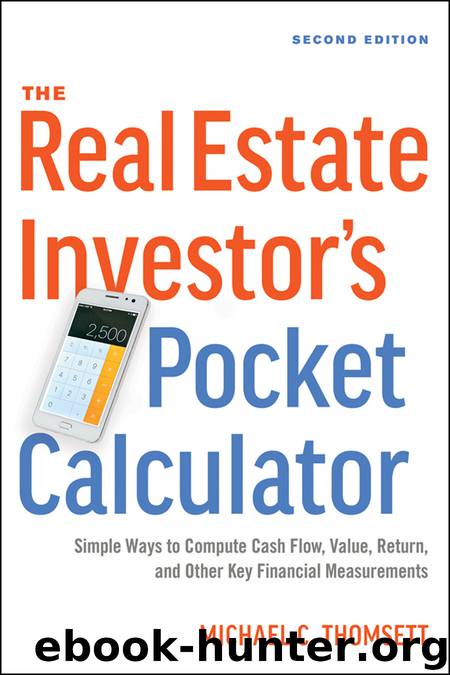The Real Estate Investor's Pocket Calculator by Michael C. Thomsett

Author:Michael C. Thomsett
Language: eng
Format: epub
Publisher: AMACOM
Published: 2017-04-07T04:00:00+00:00
Figure 8.1: Audit Trail
The final step in the process, the financial statement, contains summary information only. The general ledger is the collection point for monthly entries to each account. Journals are an organization of all of the entries of specific types. There are four journal forms:
1.Receipts journal. This is the recording point for all money coming into the business. This includes the receipt of rent, loan proceeds, and the capital you invest. The total of each month’s receipts is posted to income and cash accounts in the general ledger. The total dollar amount should be equal to bank deposits (or easily reconciled from the journal to bank records).
2.Disbursements journal. This is where all payments are recorded. While you should minimize cash transactions in the interest of clarity and consistency, it is often necessary to make some cash payments. As a general rule, this journal summarizes payments made by check, and the total entries each month should be reconciled with bank records. Cash payments are normally recorded through journal entries in the general journal. You can also reimburse yourself for each month’s cash payments by writing a check to yourself.
3.General journal. This is the book where everything that takes place outside of the checking account is recorded. This includes recording depreciation, cash expenses or income, and the breakdown of payments for capital improvements. Every transaction, by cash or otherwise, gets recorded in one of the three journals: receipts, disbursements, and general.
4.Subsidiary journal. The fourth type of journal is specialized and is used for special circumstances. The subsidiary journal is a more detailed breakdown of summarized entries occurring in one of the other journals. For example, in businesses that do a large volume of sales on account, an accounts receivable subsidiary journal is set up, with one record per customer. The sum of transactions on account (payments on balances due and new activity) are recorded on each customer card and in the other journals in summarized form. The purpose of the subsidiary journal is to manage records efficiently without making the other journals overly complex.
Source documents are the specific papers on which transactions are based. These are actual verification for every transaction you move through the system. Source documents include rental contracts, which specify how much rent a tenant owes and when it is payable; this supports the rental income you record in your books. Bank deposit receipts should back up the total of the income you report each month, and differences should be clearly explained. Other source documents explain payments made by check or in cash. This includes documents such as invoices, statements, register receipts, and vouchers. In cases where you do not get a receipt, you should write a “note to the file” and provide the date, amount, and business purpose of the expense.
That overview is a summary of what bookkeeping is all about: verification of transactions and management of volume. Note that you may have thousands of source documents and dozens of journal entries. However, you will post a
Download
This site does not store any files on its server. We only index and link to content provided by other sites. Please contact the content providers to delete copyright contents if any and email us, we'll remove relevant links or contents immediately.
Weapons of Math Destruction by Cathy O'Neil(5829)
Cracking the GRE Premium Edition with 6 Practice Tests, 2015 (Graduate School Test Preparation) by Princeton Review(4043)
What It Really Takes to Get Into Ivy League and Other Highly Selective Colleges by Hughes Chuck(3551)
Fooled by Randomness: The Hidden Role of Chance in Life and in the Markets by Nassim Nicholas Taleb(2860)
The Tyranny of Metrics by Jerry Z. Muller(2846)
The Marketing Plan Handbook: Develop Big-Picture Marketing Plans for Pennies on the Dollar by Robert W. Bly(2793)
Ultralearning by Scott Young(2730)
The Official Guide for GMAT Review 2015 with Online Question Bank and Exclusive Video by Graduate Management Admission Council (GMAC)(2643)
50 Economics Classics by Tom Butler-Bowdon(2409)
The Visual MBA by Jason Barron(1979)
The Inevitable by Kevin Kelly(1834)
Data Science for Business by Foster Provost & Tom Fawcett(1811)
Out of the Crisis by Deming W. Edwards(1759)
GMAT Official Guide 2018 Verbal Review by GMAC (Graduate Management Admission Council)(1702)
Cracking the LSAT, 2012 Edition by Princeton Review(1688)
The Personal MBA: Master the Art of Business by Josh Kaufman(1647)
The Conflict Resolution Phrase Book by Barbara Mitchell & Cornelia Gamlem(1646)
Maths and Stats for Web Analytics and Conversion Optimization by Himanshu Sharma(1564)
College Essays that Made a Difference by Princeton Review(1550)
